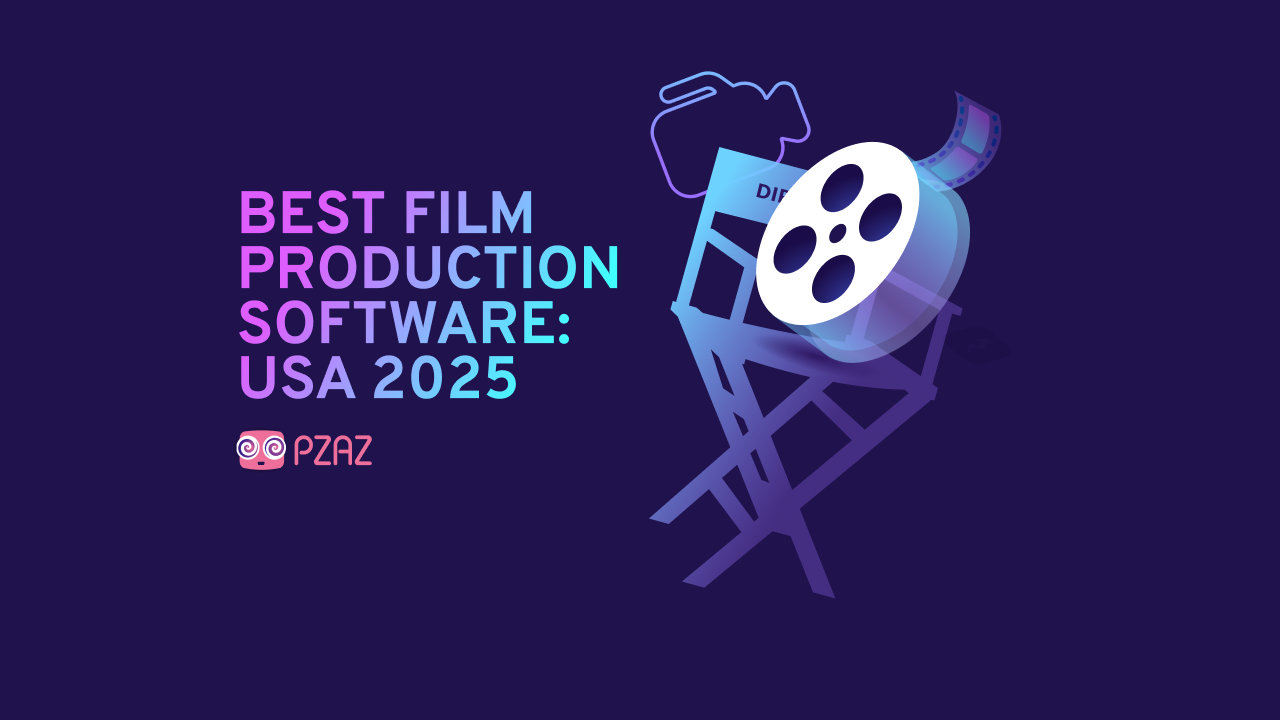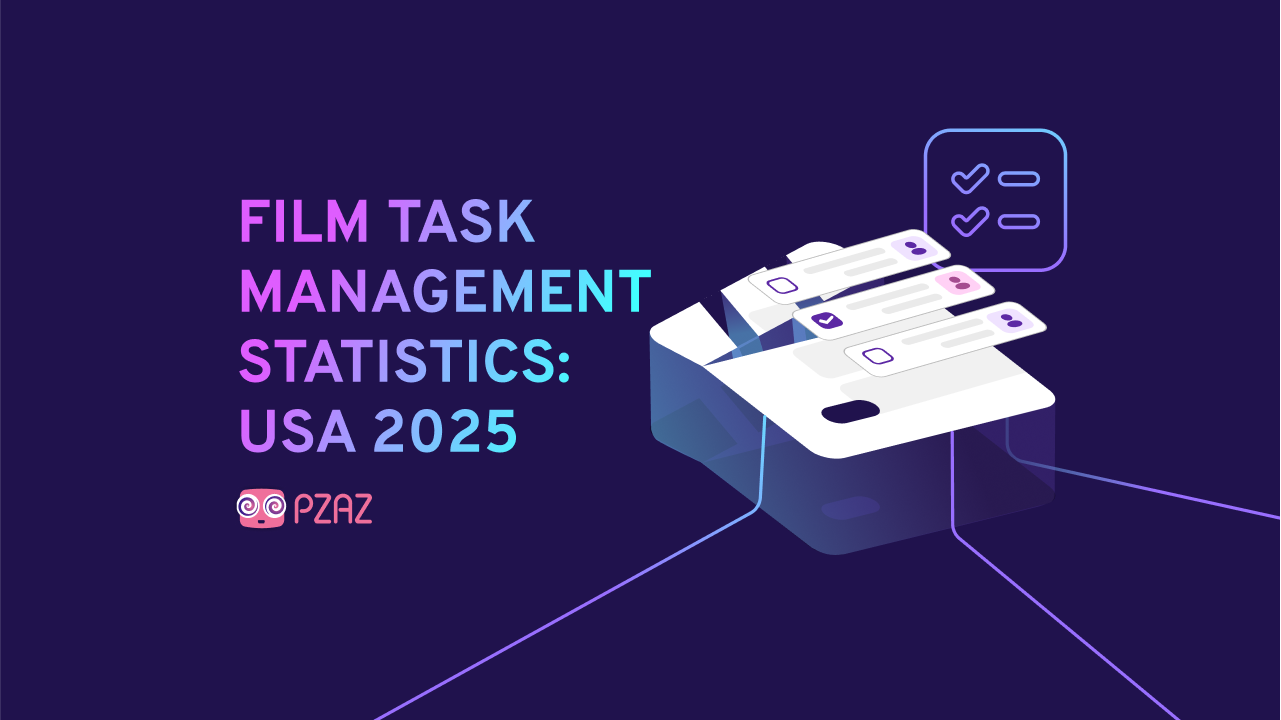
Successful filmmaking is impossible without task management, especially for independent filmmakers faced with tight budgets and timelines that leave little to no wiggle room.
To learn more about how independent filmmakers in the US manage task dependencies, we used AI-driven audience profiling to synthesize insights from online discussions over 12 months, ending May 5, 2025, to a high statistical confidence level. Our audience comprised 1,063 indie filmmakers, and their opinions gave us greater insight into how they manage tasks, collaborate with teams, and handle task dependencies. They also revealed current trends in software usage, planning strategies, and the changing role of technology in the indie film industry.
Let’s unpack what these statistics reveal.
Index
- 100% of independent filmmakers hold regular team meetings to communicate task responsibilities
- 100% of indie filmmakers rely on department leads to handle task dependencies
- 100% of filmmakers manage overlapping tasks with prioritized lists
- 100% of filmmakers monitor task completion through team updates
- 64% of filmmakers use shared to-do lists to manage tasks during production
- Voice memos used by 100% of filmmakers for spontaneous ideas
- 80% of US indie filmmakers prefer video conferencing for real-time collaboration
- Meeting deadlines the most challenging aspect of task management for 44%
- Visual task boards the most helpful for tracking task progress for 100% filmmakers
- 83% of indie US filmmakers are based in the Midwest
- Methodology
How Do You Ensure Clear Communication Of Task Responsibilities?
100% of independent filmmakers hold regular team meetings to communicate task responsibilities
It’s evident that regular team meetings are a film industry staple:
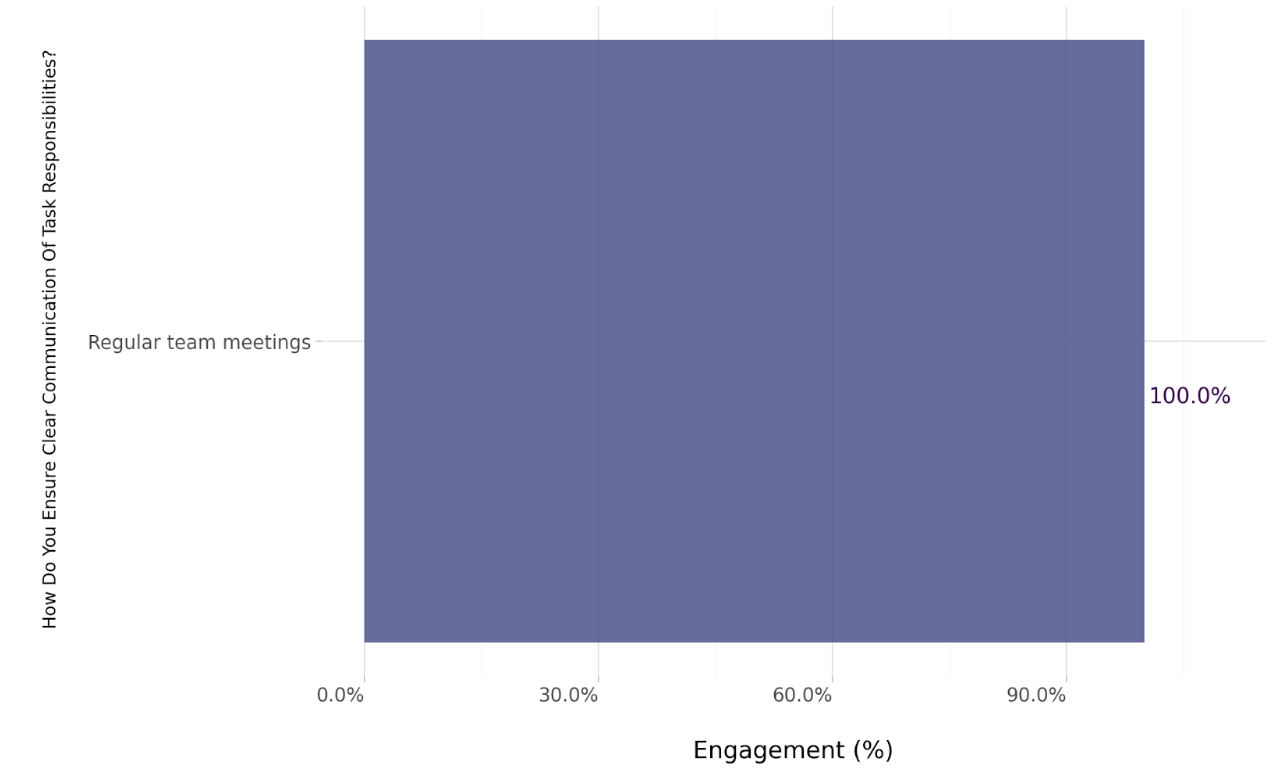
Our audience of 1,063 independent filmmakers in the US was unanimous about how they ensure that task responsibilities are communicated clearly—they rely on regular team meetings. Whether virtual or in-person, meetings remain a primary communication method not just in the film sector, but in every other business, too. Research shows that organizations spend around 15% of their collective time in meetings, highlighting their continued importance in coordinating creative, technical, and logistical efforts across a film set.
How Do You Handle Task Dependencies?
100% of indie filmmakers rely on department leads to handle task dependencies
Task dependencies are all handled in the same way:
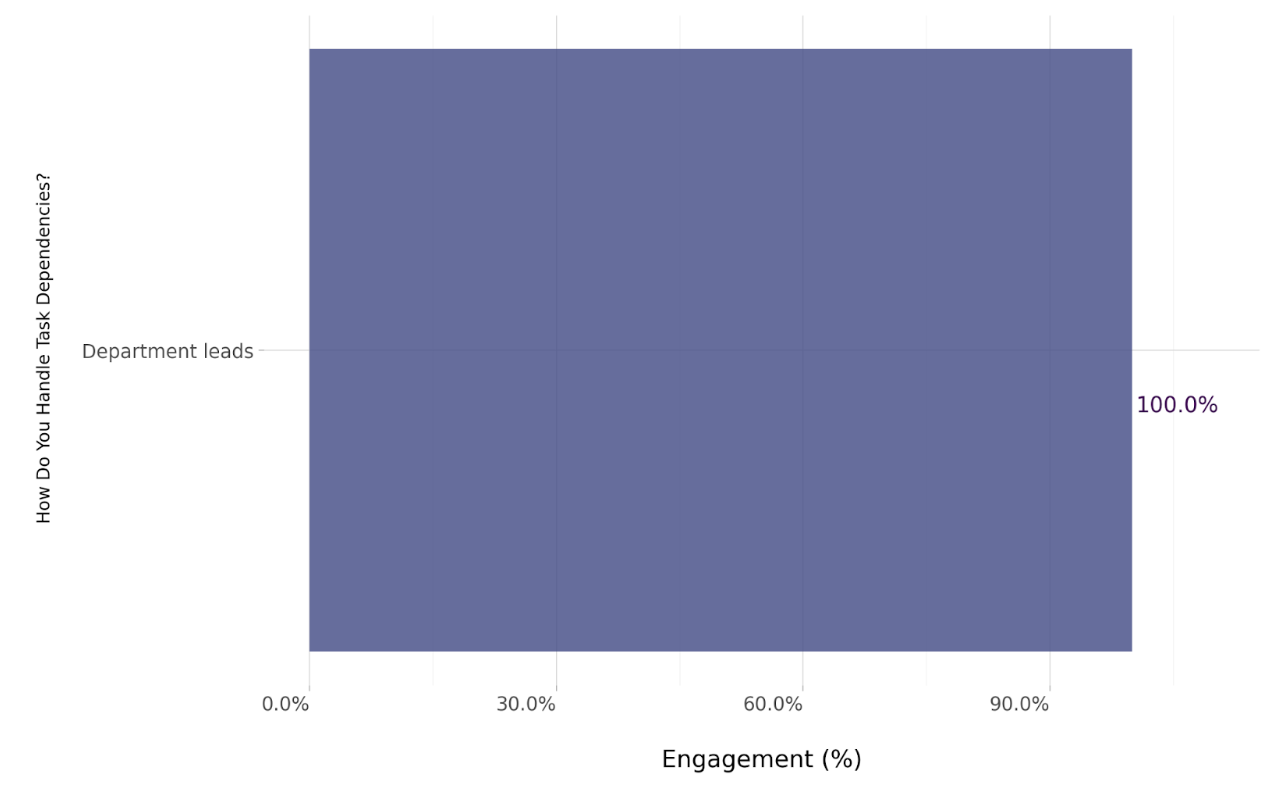
When it came to how task dependencies are handled, 100% of our audience said they rely on department leads. This is understandable, as department leads play a critical organizational and creative role in filmmaking. They’re responsible for overseeing their specific area of production and ensuring that their team’s work aligns with the director’s vision and the overall production schedule.
Despite not making it onto the list of the top 12 highest-paying jobs in the film industry, they’re the glue between vision and execution, making them essential to the success of any film project.
How Do You Manage Overlapping Tasks Across Departments?
100% of filmmakers manage overlapping tasks with prioritized lists
Prioritized lists are the go-to method for managing overlapping tasks across departments:

Filmmaking brings together talented individuals working in different departments, many of whom must perform their tasks simultaneously to produce an engaging and impactful film. Often, tasks across departments overlap. These overlapping tasks must be managed carefully to ensure that the film-making process isn’t delayed or jeopardized in other ways.
Once again, 100% of our audience of independent filmmakers said they use prioritized lists to manage overlapping tasks across departments.
This suggests that independent filmmakers recognize the complexity of managing simultaneous, interdependent tasks during production and proactively use structured tools like prioritized task lists to maintain efficiency and avoid delays. It also indicates a strong emphasis on organization and cross-departmental coordination as essential to successful filmmaking.
How Do You Monitor The Completion Of Tasks?
100% of filmmakers monitor task completion through team updates
Our entire audience took a non-invasive approach to monitoring task completion:
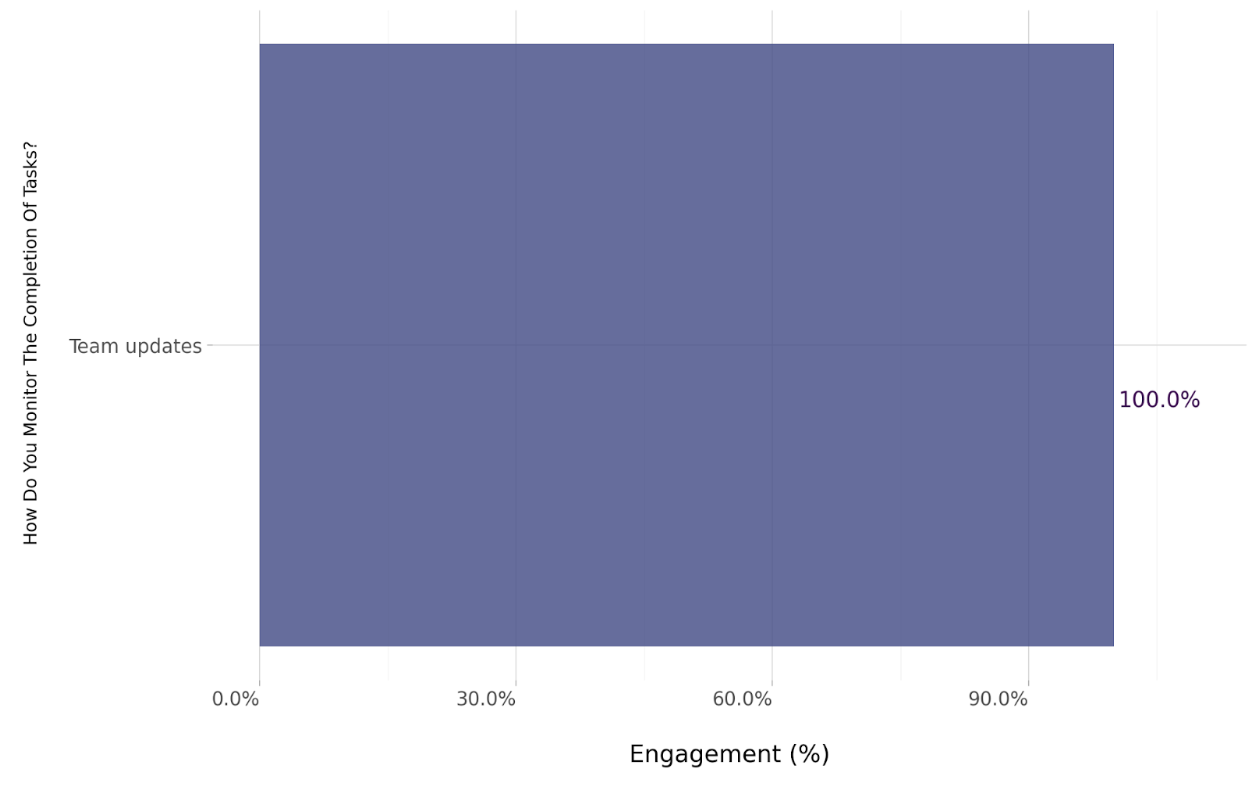
Task dependencies and overlapping tasks are common in filmmaking, and it’s essential that filmmakers monitor task completion to ensure the entire process runs smoothly. For 100% of our audience, team updates were the preferred method of doing this. This ties in with the preference for team meetings to ensure clear task communication, as it creates an open channel for discussion and updates.
How Do You Primarily Manage Tasks During Production?
64% of filmmakers use shared to-do lists to manage tasks during production
There are two preferred ways of managing production-related tasks:
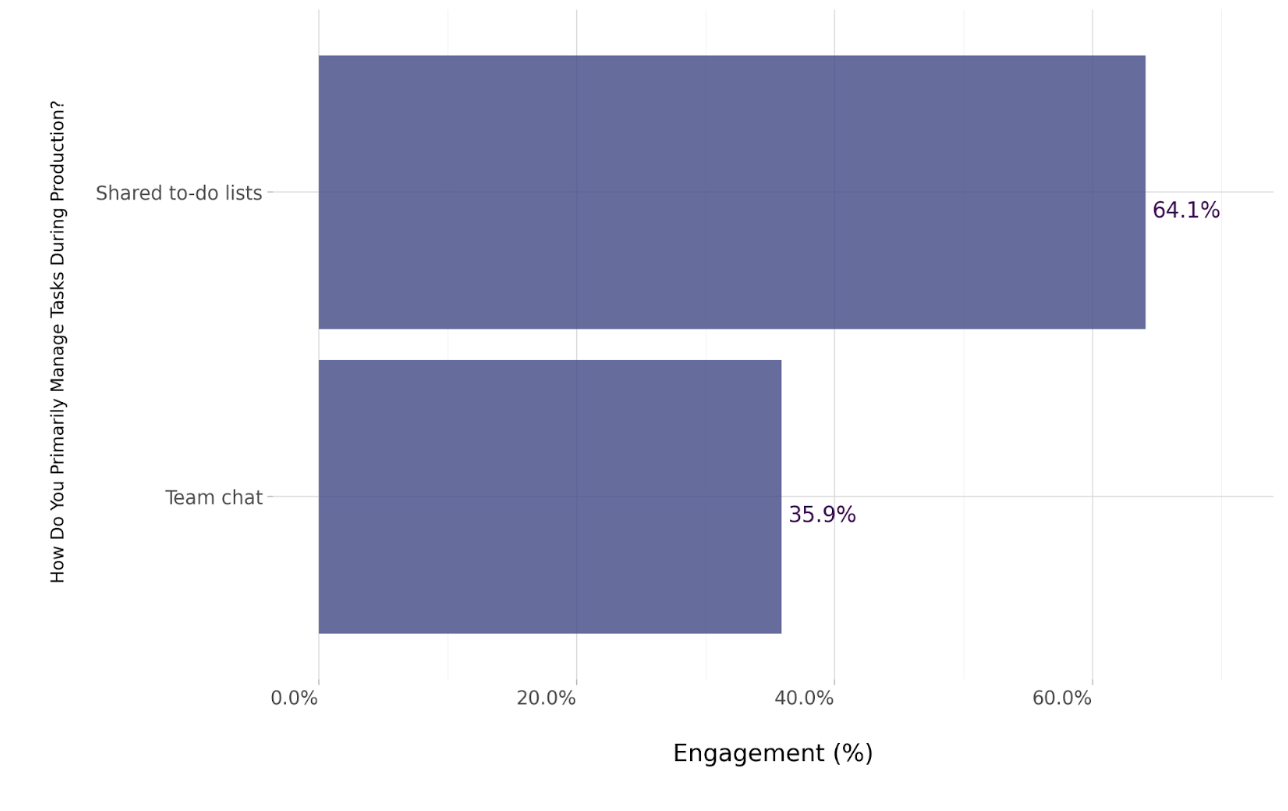
Time management and task management go hand-in-hand; in the film production process, it’s essential to ensure tasks are managed properly and timeously. For 64% of our audience, shared to-do lists were the primary way of managing tasks during film production. These independent filmmakers are not alone. A 2024 Timewatch survey found a growing reliance on to-do lists, with 48% of respondents saying they used to-do lists to manage their time. This was a 10% increase on the 38% who reported using this method in 2022.
The rest of our audience (36%) said they primarily managed their production-related tasks via team chat. This relatively low figure is in keeping with insights offered by Project.co’s 2023 Communication Statistics report, which revealed that 64% of respondents preferred using email for internal communication, while 11% used online chat, another 11% used project management tools, 9% used the telephone, and 3% preferred face-to-face interactions.
What Method Do You Use To Capture And Organize Spontaneous Ideas?
Voice memos used by 100% of filmmakers for spontaneous ideas
Creative ideas can come at any time, so it’s important to have an easy way to capture and organize them. For indie filmmakers, the same method is utilized across the board:
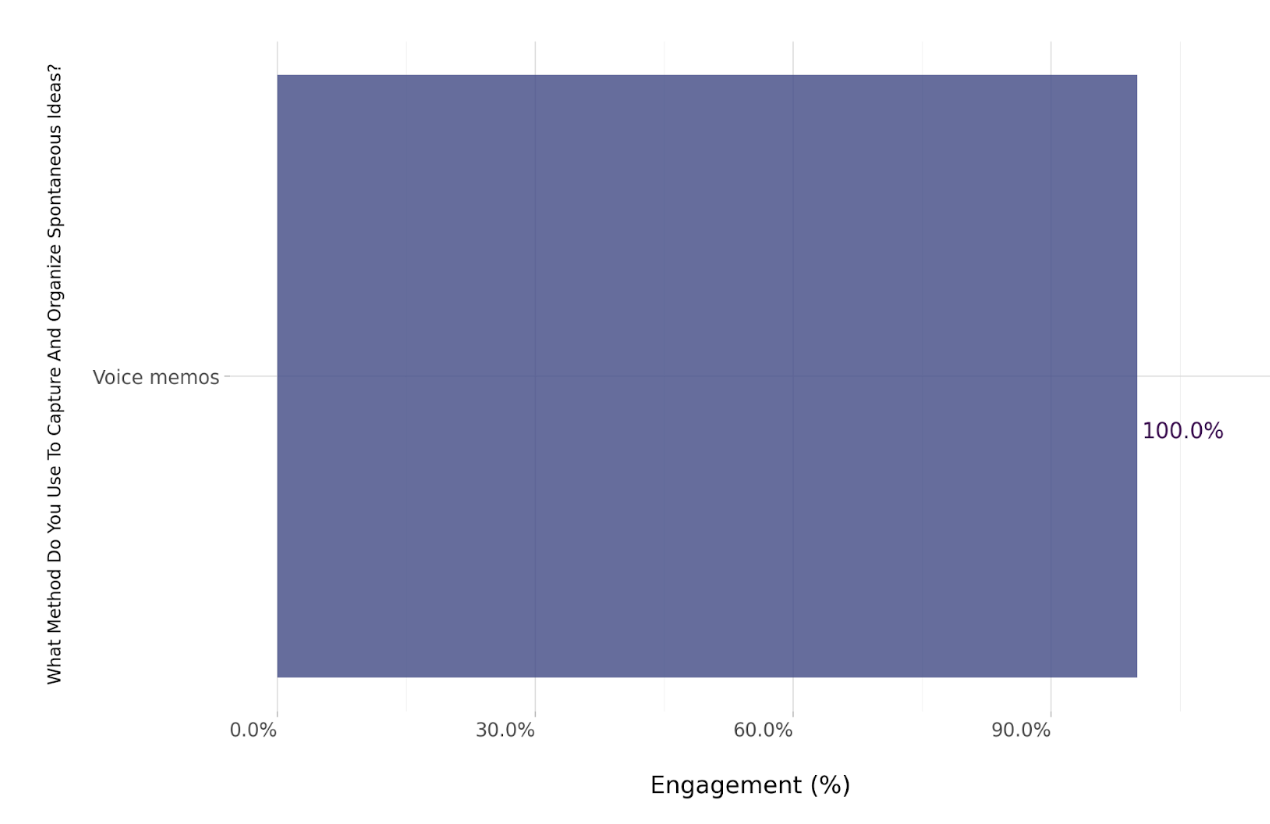
Our audience of 1,063 independent filmmakers agrees on many things, with 100% saying voice memos are the best way to capture and organize spontaneous ideas. This form of communication offers a fast, real-time way to capture creative ideas the moment they strike, without interrupting production flow. They also reduce the risk of misinterpretation compared to text-based communication, preserving tone, intent, and nuance.
This preference for voice memos is in keeping with a wider voice note trend that has swept the US over the past decade. A 2023 Vox/YouGov survey found that 62% of Americans have sent a voice message, with 30% doing so daily, weekly, or multiple times a day.
What Tools Do You Use For Real-Time Collaboration?
80% of US indie filmmakers prefer video conferencing for real-time collaboration
There’s a clear trend in our audience’s preferred tools for real-time collaboration:
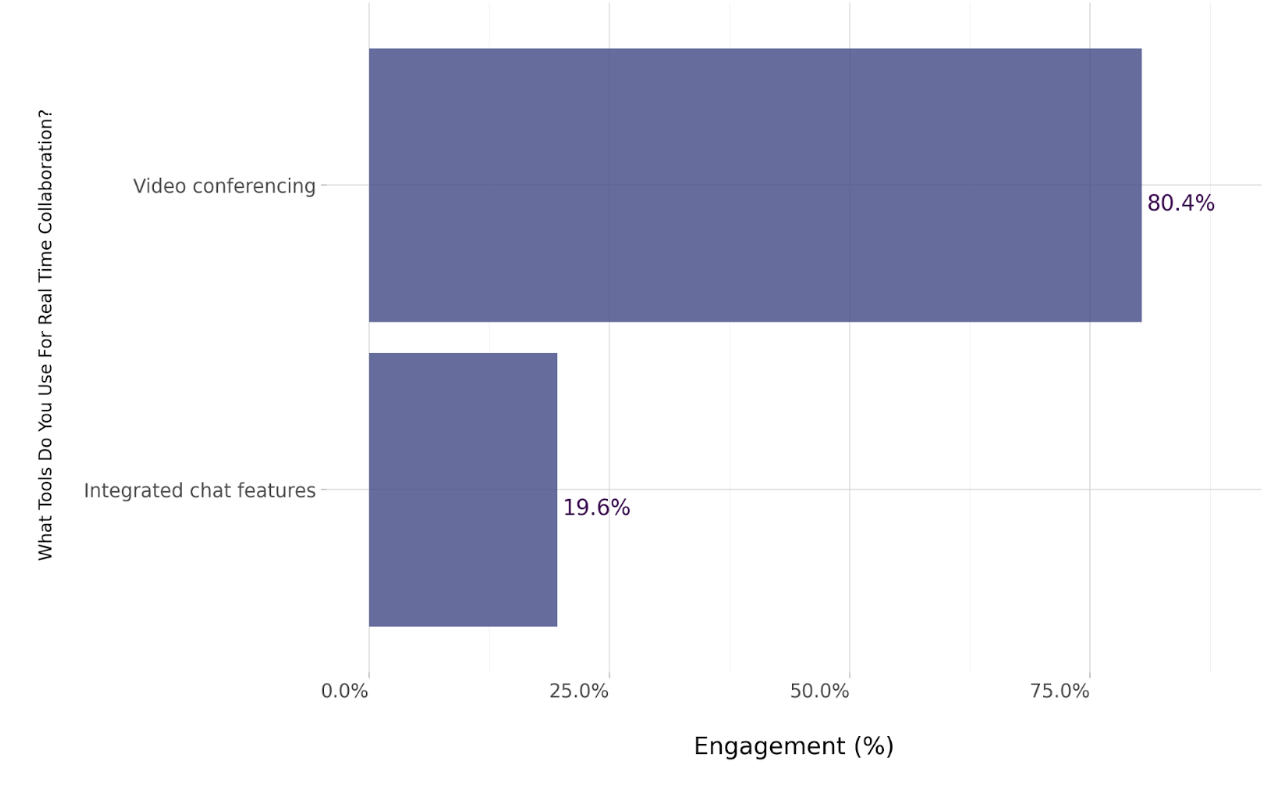
The various teams involved in making a film don’t necessarily work in the same location. For example, the director, cast, and film crew might be on set or on location, while those handling special effects, animation, sound, or accounting might be based in various studios or offices. Given the growing popularity of remote work, some people involved in the filmmaking process may even be based in other countries. With all of these and other factors at play, effective real-time collaboration is non-negotiable.
For our audience of independent filmmakers, video conferencing is the go-to tool for real-time collaboration for 80%. The remaining 20% of indie filmmakers in the US use integrated chat features on various platforms for real-time collaboration.
Already a sizable market, video conferencing continues its upward trajectory in popularity. According to Statista, the global market was worth $10.6 billion in 2022, and it’s estimated that by 2027, this figure will reach $19.1 billion. With the majority of filmmakers opting for this type of tool to facilitate real-time collaboration, the industry is clearly contributing to this growing number.
Which Aspect Of Task Management Do You Find Most Challenging?
Meeting deadlines the most challenging aspect of task management for 44%
Find out what our audience of independent filmmakers revealed about their task management challenges below:
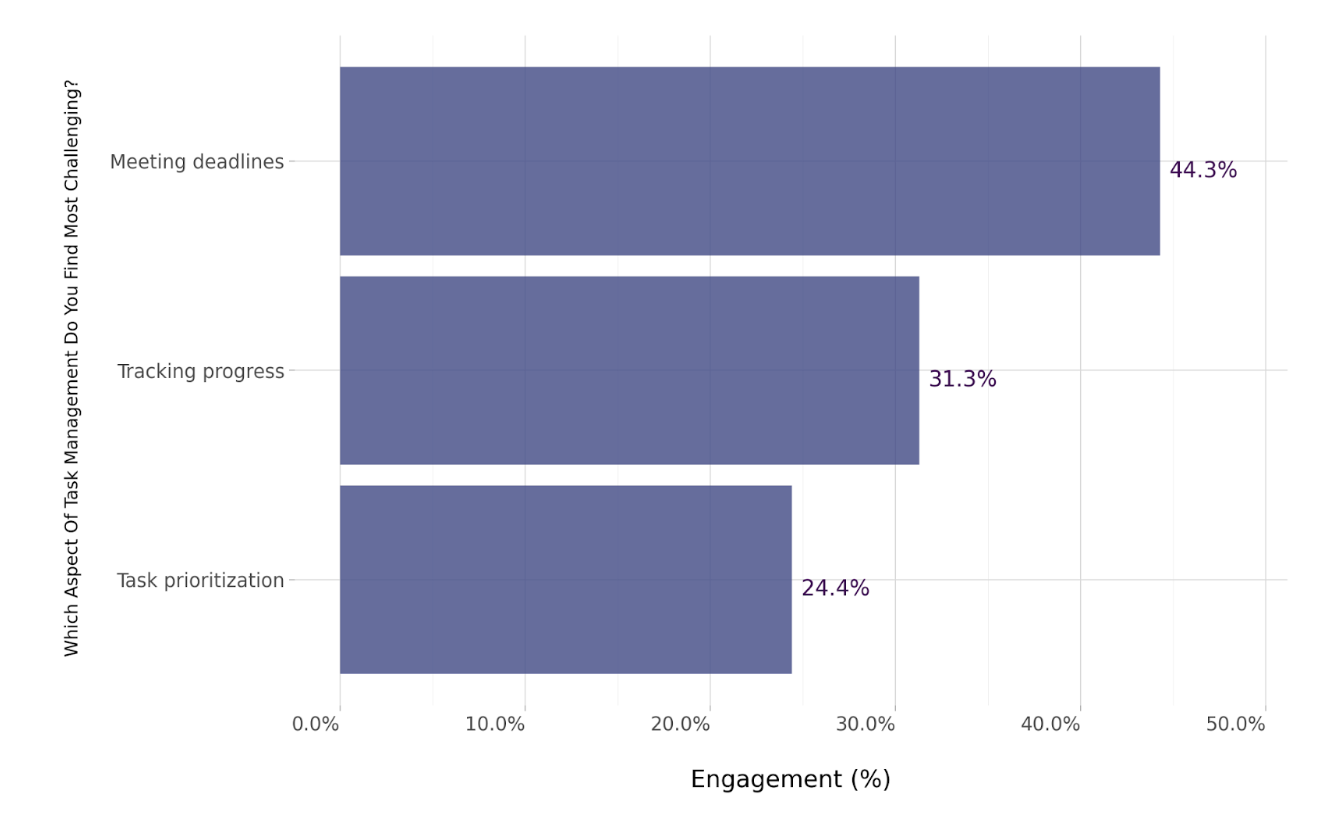
For 44% of independent filmmakers in the US, meeting their deadlines was the most challenging aspect of task management. The importance of meeting film production deadlines can’t be overemphasized.
One of the best examples of how missed deadlines can negatively impact a film is Jet Pilots, a Cold War romance starring John Wayne and Janet Leigh. Filming began in 1949, but the film was only released in 1957, by which time the “latest” jets and technologies featured in the film had become incredibly outdated.
For the rest of our audience, task management in filmmaking presented other, greater challenges. 31% said that their greatest task management challenge was tracking progress, while the remaining 24% said they struggled most with task prioritization.
These findings reveal that independent filmmakers face a range of task management challenges that can significantly impact a production’s success. Whether it’s staying on schedule, maintaining visibility over progress, or deciding which tasks to prioritize, each challenge can disrupt the delicate coordination required on a film set. The diversity of responses highlights the need for robust planning tools and clear communication practices to keep projects moving forward efficiently and creatively.
Which Feature Do You Find Most Helpful For Tracking Task Progress?
Visual task boards the most helpful for tracking task progress for 100% filmmakers
The immense popularity of visual task boards for tracking task progress in independent filmmaking is obvious:
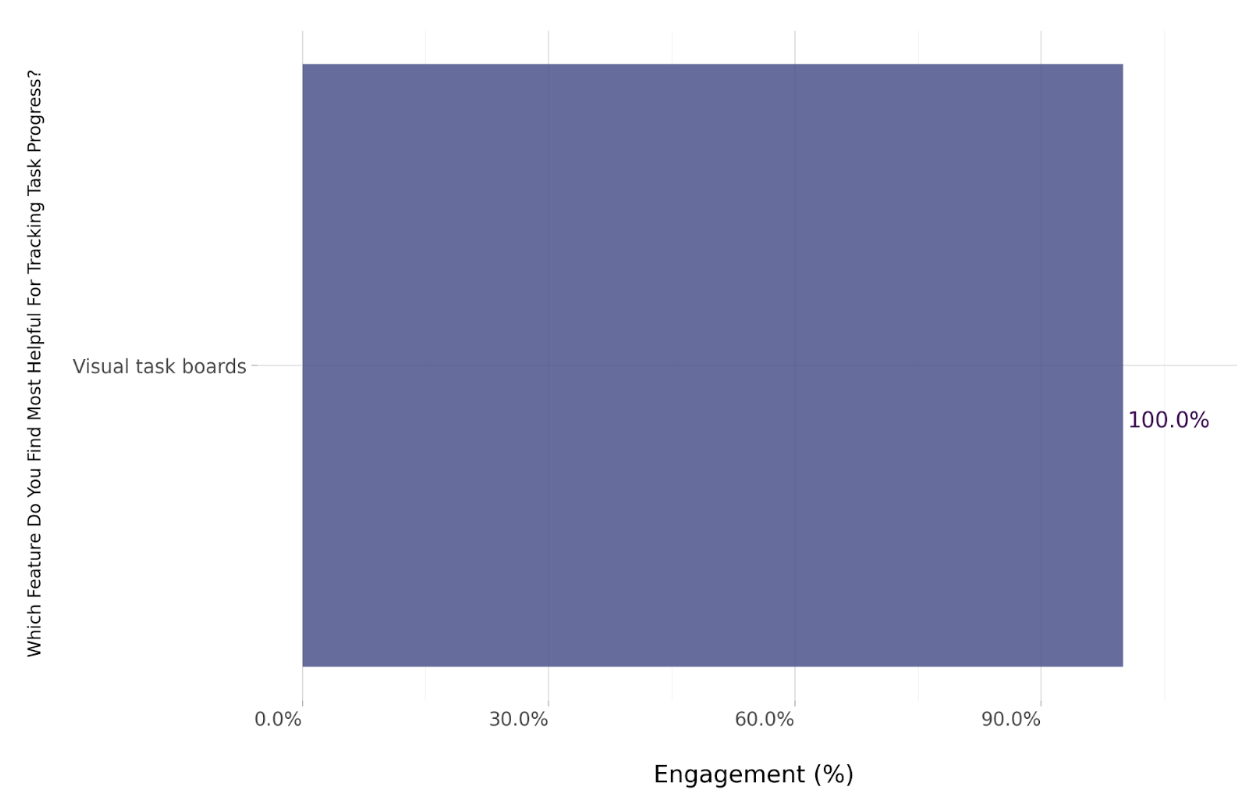
Again, our entire audience (100%) said that visual task boards were the feature that was most helpful for tracking task progress during the filmmaking process. Visual task boards provide a visual representation of the tasks that are to be done. They make it easier to assign and reassign tasks, set priorities, and update the status of various tasks, and they can be customized to suit the needs of film production teams.
Other advantages of visual task boards include enhanced team collaboration, promoting open communication, improved task tracking, streamlined workflow processes, reduced lead times, and faster identification of bottlenecks. This makes them ideal for directors and producers who need to quickly adjust schedules and resources in response to unexpected changes on set, ensuring that production stays on track.
Which Region Best Matches Your Main Production Base?
83% of indie US filmmakers are based in the Midwest
Our audience’s main production bases in the US are split in two, with one location clearly in the lead:
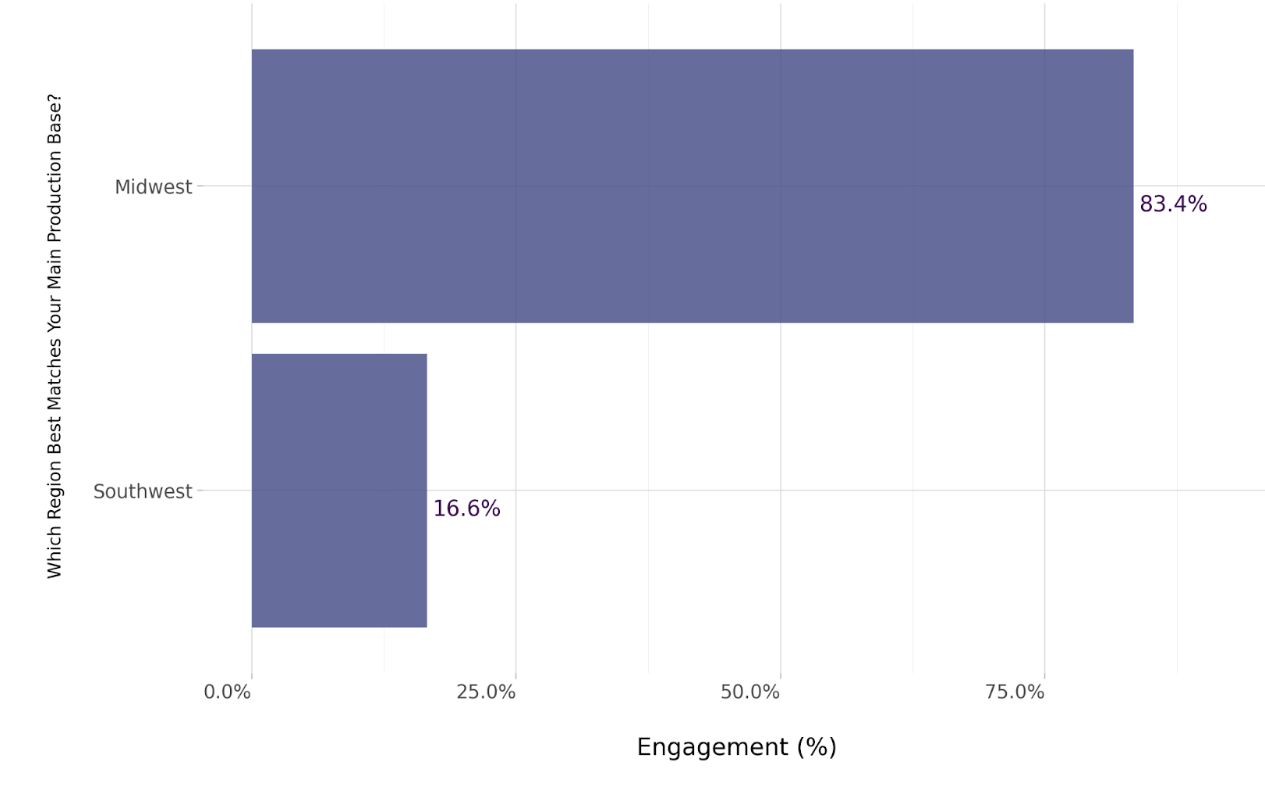
Hollywood might be the first place that people think of when they see or hear the term “filmmaker,” but for 83% of the independent filmmakers in our audience, the Midwest is their main production base. Only 17% said their main production base was in the Southwest.
Interestingly, the Los Angeles region’s share of national film and TV employment was at 27% in 2023, compared to 35% in 2022. This highlights how independent filmmakers are increasingly finding success outside traditional centers like Hollywood, while the industry as a whole becomes more geographically distributed.
Effective task management will always be essential in the independent film industry for turning creative ideas into finished productions. These 2025 statistics highlight the tools and strategies that filmmakers in the US rely on to stay organized and collaborative. Whether you’re refining your current workflow or exploring new solutions, understanding these trends can help you work smarter, ensuring your next project stays on track from pre-production to final cut.
Methodology
This data is sourced from a sample of 1,063 USA independent filmmakers’ opinions, collected through platforms such as Quora, X, Reddit, TikTok, Bluesky, and Threads. Responses are gathered within a 65% confidence interval and a 47% margin of error. Engagement reflects the number of people from the targeted location actively participating. Demographics are determined based on features like location, self-described occupation, and personal information shared publicly. Privacy is safeguarded using methods like k-anonymity and differential privacy. The results are based on online self-descriptions, as no direct questions were asked of the participants in the sample.
About the representative sample:
- 73% of independent filmmakers in the USA are over the age of 45.
- 56% identify as male and 44% as female.
- 81% earn between $500,000 and $1 million annually.
- 29% are in the South Atlantic US, 25% in the East North Central, and 25% in the Pacific.
Best Film Screenwriting Software US in 2025
Find out what independent filmmakers want most in screenwriting software—from AI tools and cloud storage to collaboration features and bold design—and see how creative needs are shaping the future of writing platforms.
Best Film Production Software: USA 2025
Find out what filmmakers value most in their software tools, from editing support to progress tracking and post-production help, and learn why Pzaz is the ultimate creative partner in bringing your stories to life.


